Related Research Articles

Triton is the largest natural satellite of the planet Neptune, and was the first Neptunian moon to be discovered, on October 11, 1846, by English astronomer William Lassell. It is the only large moon in the Solar System with a retrograde orbit, an orbit in the direction opposite to its planet's rotation. Because of its retrograde orbit and composition similar to Pluto, Triton is thought to have been a dwarf planet, captured from the Kuiper belt.
The Darian calendar is a proposed system of timekeeping designed to serve the needs of any possible future human settlers on the planet Mars. It was created by aerospace engineer, political scientist, and space jurist Thomas Gangale in 1985 and named by him after his son Darius. It was first published in June 1986. In 1998 at the founding convention of the Mars Society the calendar was presented as one of two calendar options to be considered along with eighteen other factors to consider for the colonization of Mars.
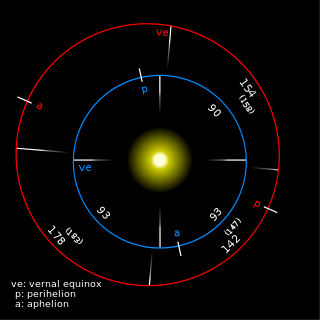
Though no standard exists, numerous calendars and other timekeeping approaches have been proposed for the planet Mars. The most commonly seen in the scientific literature denotes the time of year as the number of degrees on its orbit from the northward equinox, and increasingly there is use of numbering the Martian years beginning at the equinox that occurred April 11, 1955.

Elysium, located in the Elysium and Cebrenia quadrangles, is the second largest volcanic region on Mars, after Tharsis. The region includes the volcanoes Hecates Tholus, Elysium Mons and Albor Tholus. The province is centered roughly on Elysium Mons at 24.7°N 150°E. Elysium Planitia is a broad plain to the south of Elysium, centered at 3.0°N 154.7°E. Another large volcano, Apollinaris Mons, lies south of Elysium Planitia and is not part of the province. Besides having large volcanoes, Elysium has several areas with long trenches, called fossa or fossae (plural) on Mars. They include the Cerberus Fossae, Elysium Fossae, Galaxias Fossae, Hephaestus Fossae, Hyblaeus Fossae, Stygis Fossae and Zephyrus Fossae.

The atmosphere of Mars is the layer of gases surrounding Mars. It is primarily composed of carbon dioxide (95%), molecular nitrogen (2.8%), and argon (2%). It also contains trace levels of water vapor, oxygen, carbon monoxide, hydrogen, and noble gases. The atmosphere of Mars is much thinner than Earth's. The average surface pressure is only about 610 pascals (0.088 psi) which is less than 1% of the Earth's value. The currently thin Martian atmosphere prohibits the existence of liquid water on the surface of Mars, but many studies suggest that the Martian atmosphere was much thicker in the past. The higher density during spring and fall is reduced by 25% during the winter when carbon dioxide partly freezes at the pole caps. The highest atmospheric density on Mars is equal to the density found 35 km (22 mi) above the Earth's surface and is ≈0.020 kg/m3. The atmosphere of Mars has been losing mass to space since the planet's core slowed down, and the leakage of gases still continues today. The atmosphere of Mars is colder than Earth's. Owing to the larger distance from the Sun, Mars receives less solar energy and has a lower effective temperature, which is about 210 K. The average surface emission temperature of Mars is just 215 K, which is comparable to inland Antarctica. Although Mars' atmosphere consists primarily of carbon dioxide, the greenhouse effect in the Martian atmosphere is much weaker than Earth's: 5 °C (9.0 °F) on Mars, versus 33 °C (59 °F) on Earth. This is because the total atmosphere is so thin that the partial pressure of carbon dioxide is very weak, leading to less warming. The daily range of temperature in the lower atmosphere is huge due to the low thermal inertia; it can range from −75 °C (−103 °F) to near 0 °C (32 °F) near the surface in some regions. The temperature of the upper part of the Martian atmosphere is also significantly lower than Earth's because of the absence of stratospheric ozone and the radiative cooling effect of carbon dioxide at higher altitudes.

An ejecta blanket is a generally symmetrical apron of ejecta that surrounds an impact crater; it is layered thickly at the crater's rim and thin to discontinuous at the blanket's outer edge. The impact cratering is one of the basic surface formation mechanisms of the solar system bodies and the formation and emplacement of ejecta blankets are the fundamental characteristics associated with impact cratering event. The ejecta materials are considered as the transported materials beyond the transient cavity formed during impact cratering regardless of the state of the target materials.
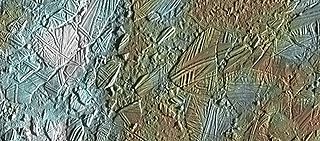
In astrogeology, chaos terrain, or chaotic terrain, is a planetary surface area where features such as ridges, cracks, and plains appear jumbled and enmeshed with one another. Chaos terrain is a notable feature of the planets Mars and Mercury, Jupiter's moon Europa, and the dwarf planet Pluto. In scientific nomenclature, "chaos" is used as a component of proper nouns.
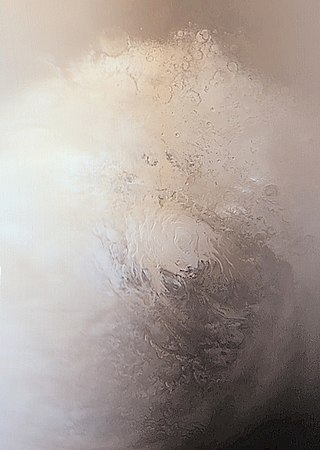
Planum Australe is the southern polar plain on Mars. It extends southward of roughly 75°S and is centered at 83.9°S 160.0°E. The geology of this region was to be explored by the failed NASA mission Mars Polar Lander, which lost contact on entry into the Martian atmosphere.

The geology of Mars is the scientific study of the surface, crust, and interior of the planet Mars. It emphasizes the composition, structure, history, and physical processes that shape the planet. It is analogous to the field of terrestrial geology. In planetary science, the term geology is used in its broadest sense to mean the study of the solid parts of planets and moons. The term incorporates aspects of geophysics, geochemistry, mineralogy, geodesy, and cartography. A neologism, areology, from the Greek word Arēs (Mars), sometimes appears as a synonym for Mars's geology in the popular media and works of science fiction. The term areology is also used by the Areological Society.

The climate of Mars has been a topic of scientific curiosity for centuries, in part because it is the only terrestrial planet whose surface can be directly observed in detail from the Earth with help from a telescope.
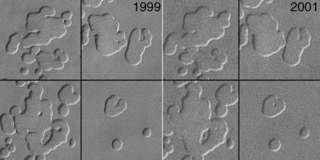
Swiss cheese features (SCFs) are curious pits in the south polar ice cap of Mars named from their similarity to the holes in Swiss cheese. They were first seen in 2000 using Mars Orbiter Camera imagery.
Thermophysics is the application of thermodynamics to geophysics and to planetary science more broadly. It may also be used to refer to the field of thermodynamic and transport properties.

Mars is the fourth planet and the furthest terrestrial planet from the Sun. The reddish color of its surface is due to finely grained iron(III) oxide dust in the soil, giving it the nickname "the Red Planet". Mars's radius is second smallest among the planets in the Solar System at 3,389.5 km (2,106 mi). The Martian dichotomy is visible on the surface: on average, the terrain on Mars's northern hemisphere is flatter and lower than its southern hemisphere. Mars has a thin atmosphere made primarily of carbon dioxide and two irregularly shaped natural satellites: Phobos and Deimos.

Martian geysers are putative sites of small gas and dust eruptions that occur in the south polar region of Mars during the spring thaw. "Dark dune spots" and "spiders" – or araneiforms – are the two most visible types of features ascribed to these eruptions.
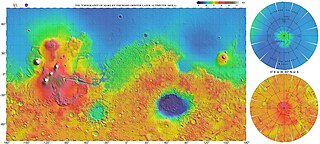
The most conspicuous feature of Mars is a sharp contrast, known as the Martian dichotomy, between the Southern and the Northern hemispheres. The two hemispheres' geography differ in elevation by 1 to 3 km. The average thickness of the Martian crust is 45 km, with 32 km in the northern lowlands region, and 58 km in the southern highlands.

Almost all water on Mars today exists as ice, though it also exists in small quantities as vapor in the atmosphere. What was thought to be low-volume liquid brines in shallow Martian soil, also called recurrent slope lineae, may be grains of flowing sand and dust slipping downhill to make dark streaks. While most water ice is buried, it is exposed at the surface across several locations on Mars. In the mid-latitudes, it is exposed by impact craters, steep scarps and gullies. Additionally, water ice is also visible at the surface at the north polar ice cap. Abundant water ice is also present beneath the permanent carbon dioxide ice cap at the Martian south pole. More than 5 million km3 of ice have been detected at or near the surface of Mars, enough to cover the whole planet to a depth of 35 meters (115 ft). Even more ice might be locked away in the deep subsurface.

The history of Mars observation is about the recorded history of observation of the planet Mars. Some of the early records of Mars' observation date back to the era of the ancient Egyptian astronomers in the 2nd millennium BCE. Chinese records about the motions of Mars appeared before the founding of the Zhou dynasty. Detailed observations of the position of Mars were made by Babylonian astronomers who developed arithmetic techniques to predict the future position of the planet. The ancient Greek philosophers and Hellenistic astronomers developed a geocentric model to explain the planet's motions. Measurements of Mars' angular diameter can be found in ancient Greek and Indian texts. In the 16th century, Nicolaus Copernicus proposed a heliocentric model for the Solar System in which the planets follow circular orbits about the Sun. This was revised by Johannes Kepler, yielding an elliptic orbit for Mars that more accurately fitted the observational data.
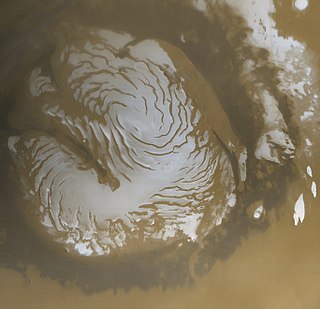
The planet Mars has two permanent polar ice caps. During a pole's winter, it lies in continuous darkness, chilling the surface and causing the deposition of 25–30% of the atmosphere into slabs of CO2 ice (dry ice). When the poles are again exposed to sunlight, the frozen CO2 sublimes. These seasonal actions transport large amounts of dust and water vapor, giving rise to Earth-like frost and large cirrus clouds.

The dwarf planet Pluto has an unusual set of climate zones, due to its atypical axial configuration. Five climate zones are assigned on the dwarf planet: tropics, arctic, tropical arctic, diurnal, and polar. These climate zones are delineated based on astronomically defined boundaries or sub-solar latitudes, which are not associated with the atmospheric circulations on the dwarf planet. Charon, the largest moon of Pluto, is tidally locked with it, and thus has the same climate zone structure as Pluto itself.

Louth is an impact crater on Mars located at 70.19°N 103.24°E in the Mare Boreum quadrangle. Located within Vastitas Borealis, the crater has a diameter of 36.29 kilometres and is named after Louth, a town in Ireland.
References
- ↑ Clancy, R. T.; Sandor, B. J.; Wolff, M. J.; Christensen, P. R.; Smith, M. D.; Pearl, J. C.; Conrath, B. J.; Wilson, R. J. (2000-04-25). "An intercomparison of ground-based millimeter, MGS TES, and Viking atmospheric temperature measurements: Seasonal and interannual variability of temperatures and dust loading in the global Mars atmosphere". Journal of Geophysical Research: Planets. 105 (E4): 9553–9571. doi: 10.1029/1999JE001089 .
- 1 2 Piqueux, Sylvain; Byrne, Shane; Kieffer, Hugh H.; Titus, Timothy N.; Hansen, Candice J. (May 2015). "Enumeration of Mars years and seasons since the beginning of telescopic exploration". Icarus. 251: 332–338. doi:10.1016/j.icarus.2014.12.014.
- ↑ "Mars Climate Database v6.1: The Web Interface". www-mars.lmd.jussieu.fr. Retrieved 2023-01-29.
- ↑ De Mottoni Y Palacios, G. (1975). The appearance of Mars from 1907 to 1971: Graphic synthesis of photographs from the I.A.U. center at Meudon. Icarus, 25(2), 296–332
- ↑ DE MOTTONI, G. (1959). Nuove carte del pianeta Marte sulla base delle fotografie del Pic-du-Midi. A T T I Soc. Astr. Ital., September, pp.1955-1957
- 1 2 3 Kuiper, Gerard P. (1957). "1957ApJ...125..307K Page 307". The Astrophysical Journal. 125: 307. Bibcode:1957ApJ...125..307K. doi:10.1086/146309 . Retrieved 2023-01-29.
- 1 2 Millman, Peter M. (1957). "1957JRASC..51..129M Page 129". Journal of the Royal Astronomical Society of Canada. 51: 129. Bibcode:1957JRASC..51..129M . Retrieved 2023-01-29.
- ↑ Tricart, Jean (1986). "Le relief de la planète Mars, comparaison avec celui de la Terre". Annales de Géographie. 95 (530): 401–444. doi:10.3406/geo.1986.20433. ISSN 0003-4010.
- ↑ Křivský, L.; Čech, J.; Sadil, J. (March 1965). "Disappearance of the Polar Cap on Mars in 1956 after a Solar Flare with Ejection of Particles". Nature. 205 (4975): 994. doi: 10.1038/205994a0 . ISSN 1476-4687. S2CID 43621160.
- ↑ "Mars at opposition". stjerneskinn.com. Retrieved 2023-01-29.
- 1 2 Zurek, Richard W. (1982-05-01). "Martian great dust storms: An update". Icarus. 50 (2): 288–310. doi:10.1016/0019-1035(82)90127-0. ISSN 0019-1035.